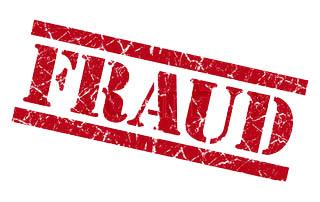Submitted by nsscadmin on

So far our Fraudster Friday series have focused on some of the most famous fraudsters in history. You may not have known all the details behind the names Ponzi, Madoff and Bre-X, but most people have heard of them.
When investors hear about the Ponzi’s, the Madoffs or the Earl Jones’ of the world, many think nothing like that could ever happen to me, I’m not a big enough fish in the investing world for scammer to go after. Unfortunately, they’re wrong about that. A third of all fraud victims are taken for less than $1,000. Another 27 per cent lose between $1,000 to $5,000. You don’t have to be wealthy to be targeted by fraudsters.
For the final post in our series we’re going to change things up a bit. Instead of looking at another famous fraudster, today we’re going to look at local fraudsters who scammed and stole from Nova Scotian investors. We have three examples of investment fraud that took place right there in Nova Scotia. To protect the privacy of the victims we’re not going to use names, but be assured, the following is real and happened here in Nova Scotia. We hope by telling these stories we can help Nova Scotians learn how scams and frauds are perpetrated and avoid having them repeated in the future.
Our first story of Nova Scotia Fraudsters deals with affinity fraud, and the always popular Ponzi scheme. In 2006 Mr. Q and Mr. H began operating an investment business, Company J, in Nova Scotia. They did not register with the Nova Scotia Securities Commission, and they did not file a prospectus to distribute securities. Once their unregistered business was established they began soliciting investors both in and outside Nova Scotia. They also solicited members of their local church, using their trust in the community and word of mouth to bring in investors.
On their website they promised outlandish returns, including turning $10,000 into $1 million in four years and 10 per cent per month interest, compounded, which would come to 214 per cent annually. In 2006 Company J received $4.13 million to invest from 137 residents of Nova Scotia and 52 residents of other provinces. To invest with Company J, investors were required to wire-transfer their funds to a bank account in Curacao, Netherland Antilles.
None of the money was invested or used to purchase securities of any kind. Instead Mr. Q used the money for personal expenses, including the purchase of three vehicles and a boat. He also transferred large amounts of the money to other accounts and made large withdrawals from ATMs totaling nearly $129,000.
Here’s where it gets a little weird. Investigators began to look into Company J and Mr. Q bolted. He ended up in Panama, where he was jailed for 19 months before being extradited back to Canada.
Back in Nova Scotia Mr. Q, who was identified as the mastermind behind the investment scheme, plead guilty to one count of fraud over $5,000. He was sentenced to a year’s probation and time served, and also ordered to pay his victims $1.1 million in restitution.
Our second Nova Scotia investment fraud story looks at Mr. A. In 2007 Mr. A promoted a highly leveraged investment strategy to his clients, despite the fact it was unsuitable for them as they were unable to qualify for the loans necessary to follow through on such a strategy.
That didn’t stop Mr. A, who forged and falsified loan applications and know your client forms for his clients. On the forged forms he inflated the value of their assets, reduced or omitted their liabilities and lied about their employment. This was all done without his clients’ knowledge and allowed him to open accounts, secure loans and purchase securities for his clients that were unsuitable.
Over six months in 2007 Mr. A illegally borrowed and invested over $14 million for his clients. This also allowed him to collect nearly $594,000 in commissions and fees.
The financial downturn of 2008 brought Mr. A’s illegal activities to light. He was charged with 21 counts of forgery and fraud and subsequently plead guilty to four charges. He was handed an 18-month conditional sentence. The Nova Scotia Securities Commission also levied sanctions Mr. A permanently barring him from working in the investment industry and an administrative penalty of $1,050,000.
Our third Nova Scotia is about Mr. D. A registered dealing representative for more than a decade, Mr. D. swindled his clients out of millions of dollars. The eventual charges and sanctions brought against Mr. D. stem from his actions against three clients.
Mr. D began scamming his first clients in the mid-2000s. He accepted personal cheques made out to him totaling more than $50,000. None of this money was invested, and was instead deposited by Mr. D and used as he saw fit. Also during this time Mr. D recommended his clients sell mutual funds and use the proceeds to (over $200,000) to purchase a different fund. Upon review, there was no benefit to the client in this sale, but Mr. D did received $7,500 in the transaction.
Mr. D then recommended his clients direct some of their savings to an off-shore investment account. This account was never opened, but Mr. D did accept personal cheques in the value of $149,500 that was to be deposited into this non-existent account. He advised his clients that this money was being invested offshore, when it was being used for his personal expenses.
When Mr. D’s illegal activities came to light, he was charged with four counts of fraud. He pleased guilty to one count and was sentenced to three years in prison. The Nova Scotia Securities Commission also sanctioned Mr. D with an administrative penalty of $350,000.
Here are the red flags to watch for to avoid getting taken by the next Mr Q, Mr A and Mr D:
You were promised a high return for low risk.
You are being given confidential or inside information.
You are required to pay for your investment by credit card or wire transfer.
Is there a credible source that can validate the investment?
Your adviser or securities salesman is not registered in Nova Scotia.
You’re asked to make out cheques to your adviser.

